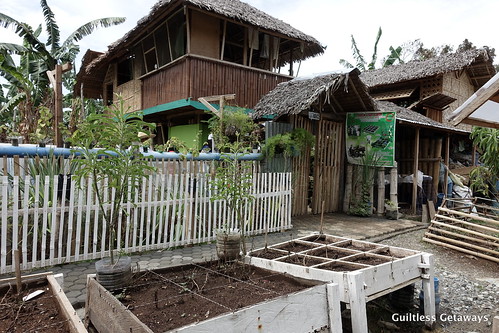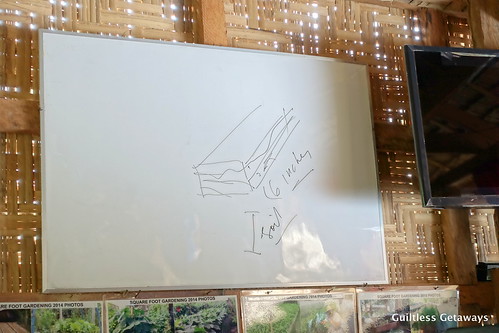After being cooped up in the office for more than four months, I finally got to fly again - to a fun place that J says he wouldn't mind going back to with me! He went on a CDO-Camiguin adventure a few years ago and I may have purposely missed it coz I didn't want the white water rafting and physical stuff way back then. Haha. I guess I prefer the sometimes rigorous (long walking under the sun) but educational farm trips spearheaded by the Agricultural Training Institute (ATI) of the Philippine Department of Agriculture (see my label under Organic Journey for more farms I visited around the country). ;) A boodle fight feast (!) at the Cervantes Farm is our official welcome to Cagayan de Oro city. The slow and still-city setting lunch and introduction to square foot urban gardening (farming using a little space) perfectly eased my transition from Manila lifestyle to a more simple way of living in the countryside. Our 4D3N CDO-Bukidnon itinerary was jampacked with farms with interesting agricultural practices and forest encounters this time! :)
I looked outside the window before landing and saw lots of mountains with clouds, making me excited to explore the highlands and the heart of Mindanao :) We arrived via PAL at the Laguindingan Airport in Misamis Oriental, just an hour away from Cagayan de Oro city. Ms. U from ATI Northern Mindanao said it's the closest access to this area.
The small airport was modern and we deplaned using a tube to get to the carousel area for our bags. I saw 2 restrooms, one crowded near the baggage area was the first one I saw
and I saw another at the corner right below, probably better, just a door away.
We left 11:20 a.m. (perfectly in time for lunch haha) and reached Mang Honorio Cervantes' Farm in CDO by 12:20 p.m. Like the others we went to nationwide, his was also an ATI-accredited learning site open to farmers, students and the public. It's the first time I've heard of the "new square foot organic urban gardening" method and it's probably one that could easily be adopted by city dwellers like myself and first-time farmers (or those with limited space).
FYI, one square foot is really just a square you'll see below. Then, you just make it into a 3x3 (3 squares by 3 squares) grid, 2x2, 4x4 or more if you want more produce.
I liked the entrance of his house. There were rows of edible plants growing which were placed in recycled containers made of plastic and retrofitted PVC pipe.
A smiling, retired Manila police officer and barangay kagawad Honorio Cervantes of Brgy. Pagatpat of Cagayan de Oro City warmly greeted us and hinted to us that he experimented with a new style of lunch in the hopes that we better understand what kind of farming and gardening he is advocating.
He is for a more organized urban farming which can provide enthusiasts with food and income the whole year round. He borrows this idea from Mel Batholomew (the founder of square foot gardening from Utah, USA) and modifies it to a Filipino setting.
I loved that the areas are so tiny in his farm house like this space. Aside from maximizing the big square (I saw lots of squares on this day haha), it gave me a sense of being single-minded for a change - a glimpse of what you can accomplish if you stick to one idea at a time and summarize the data properly for monitoring.
We headed up his multi-purpose room, where he holds some trainings, for lunch.

We were served a buko salad drink and lots of mangoes and banana aside from the main entree =)

This is a view from the window. You can see his mobile 4x4 kangkong demo unit.

The inside is only as big as this 4x4 boodle fight setup, enough to feed more than 40 people in my estimate. Probably due to his military background, Mr. Cervantes was inspired to create a fun (and delicious!) experience for us hungry folks who came all the way from Manila to see him. Hehe.

He used bani (banana false trunks or stems, eaten in other cuisines) as our plates then we ate kamayan-style (by hand) =)
I went (maybe thrice) for the rice, yummy lato and tender pork smothered in super good sauce. They sure can cook well hehe. If we had enough time (which we didn't...), there was supposed to be some more fresh kangkong picking, cooking, and eating part.
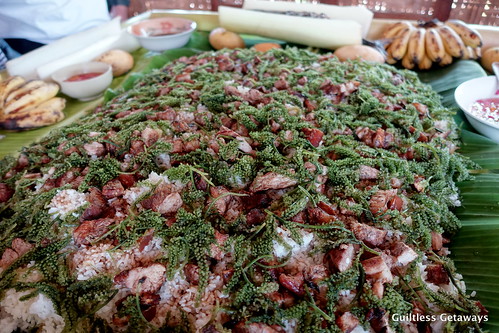
We did a lot of eating while listening to Mang Honorio's stories about the farm and his chosen method. Basically, crops are planted densely in raised beds (not on the ground directly hence the term "New" in New Squarefoot Gardening). For land preparation, he layers 2 hollow blocks (1 and 2 below) and line the growing area forming a square to house a 6-inch bed of Cervantes mixed soil. He puts seven items in it including bamboo charcoal, lime, sand, manure and gravel.

For irrigation and maintenance, he says he uses a trovel because using a hose is too much and will make holes when you irrigate.

Plant spacing is important in this method. Each square in a 4x4 plot can be a different plant so as to have variety and for companion planting benefits in terms of pest control. In my opinion, this answers surplus in farm produce which may turn into waste because you can just plant a little of each. =) But the number of plant per square foot you can plant differs according to plant size so you can use the sample below as your guide.


To use the patterns, you simply put them above the soil and poke holes with a nail. You can see from this pattern that you can plant 36 seeds. For some added input, Manong Cervantes experimented successfully doubling this amount per square foot already. Therefore doubling his produce as well ;)

Here, one seed is planted at a time so in essence, you make every little seed work at a cost-effective space and even with limited water supply.

Mr. Cervantes said he always carries with him a calculator so that he can show people how easy it is to calculate per square feet your projected earnings ("it takes 900 square to be a millionaire") if you want to venture into that. He chose kangkong as his cash crop. =) In Manila, the prevailing thought is that you are poor when you eat kangkong, but he might just change that with this. I would always remember Mr. Pat Acosta of the Master's Garden saying that growing one pack of seeds (costs less than P100) is worth so much more. And not a lot of people probably see that. Not one seed must be taken for granted.

There's one more treat in this tiny urban farm that's hidden and can be accessed above one of the structures.

There's fish in there and you have to be careful not to fall in haha. My guess is that they use this fertile water to water the plants.

There's no farm stay here yet but a lovely afternoon up here reading out of the sun and looking down the plots would be nice. Just really make sure that the bamboo latch with the fish hole is closed. Haha.

I believe we ran out of kangkong for personal consumption and time haha. So come here with a plan and contact them way ahead for any activity. They are also working on a Philippine Good Agricultural Practices (GAP) certification which includes food handling and safety.

These are some more of the OC things I learned from this farm to apply. A color-coded cropping calendar by plot! Hehe.

The farmer's record book I think is very important as it records your produce per harvest. Mighty fun if someone can take pictures also per harvest hehe.
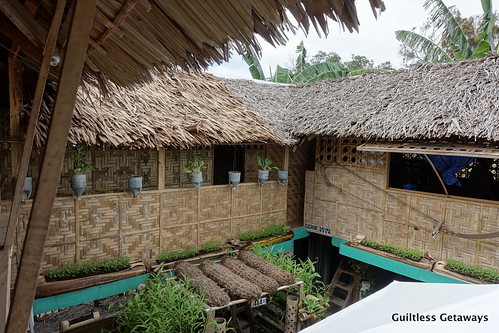
Down here a plot is made up of different blocks then per block are squares. You may call it anything you like haha.

Each block is separated by a clever colored line. They also fabricate their own hollow blocks and use native makeshift materials.

Hold like this and imagine a plate of fresh adobong kangkong or what others will be willing to pay for an organically grown produce hehe.
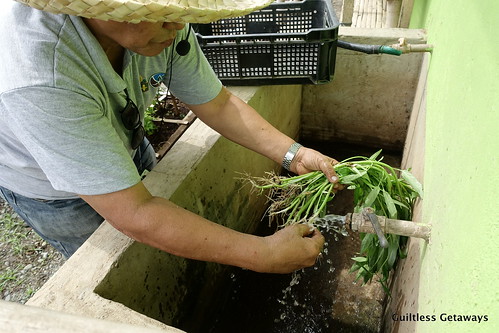
Mang Honorio Cervantes is so hip and helpful, he's also assisting farmers and inmates to do this in their own backyard, hoping that one day they can be self-sufficient first, sparked by a transformation from within, that they stop lining up and waiting to be fed, and start planting anytime and anywhere (even the low maintenance and resilient kangkong) to answer food deficiency one square foot at a time.
Farm Details:
Zone 5, Brgy. Pagatpat, Cagayan de Oro City,
To visit the different ATI-assisted projects (Organic Farming Learning Sites or soon-to-be pending certification), you can drop by or ask the ATI Regional Training Center nearest you or inquire through:
Call -
982AGRI (982-2474) for Metro Manila calls
1-800-10-982AGRI (1-800-10-9822474) for provincial toll-free calls using PLDT landlines
Text -
For Smart and Talk & Text Subscribers, send a message to 391-DA (391-32).
For non-Smart Subscribers, send a message to 0920-946AGRI (0920-9462474).





